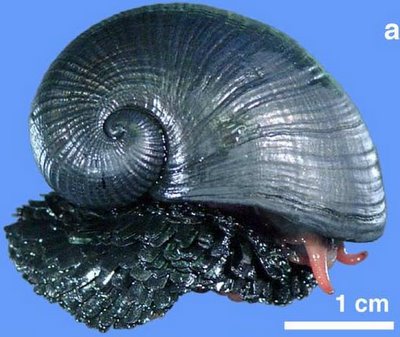
The as yet un named “scaly foot” gastropod is undoubtedly one of the coolest organisms to be discovered in recent years (1). It’s truly remarkable feature is that the exposed parts of it’s body are covered with overlapping scales of iron sulphide that look for all the world like armour. New research about how this remarkable feature is made has just appeared in ‘Earth and Planetary Science Letters’ (2).
It was previously thought that the iron sulphide could be derived from symbiotic bacteria that are associated with the scales (3). This does not seem to be the case as the isotopic composition of the scales resembles that of the vent fluids and not bacterial metabolites. But it does seem that the control of iron sulphides in cells by this snail which was probably a necessary precursor to the ‘armour’ is related to symbiosis with the bacteria that provide the gastropod with food. These bacteria live inside the esophageal glands (3) and seem to provide the snail with all of it’s nutrition as it has an atrophied gut. The bacteria convert sulphides into compounds that the bacteria and snail can use so it is likely that the snail can regulate intracellular sulphides. It is suggested that it is this adaptation that provided the precursor to ‘snail armour’. Unsurprisingly the researchers also conclude that the function of these scales is for defense possibly against brachyuran crabs.
 The snail's home at the base of a vent, showing crabs and shrimp.
The snail's home at the base of a vent, showing crabs and shrimp.
There is still much to find out about this snail. For example it is not known exactly how the snail controls the iron sulphides what genes are involved in this process and how it is regulated, hopefully further research will reveal more about this incredible creature.
1) A Hot-Vent Gastropod with Iron Sulfide Dermal Sclerites. Science 7 November 2003: Vol. 302. no. 5647, p. 1007 DOI: 10.1126/science.1087696. http://www.marinegeo.uni-bremen.de/pub/pdf/PDF-Datein/2003/Waren_2003_a.pdf
2) Suzuki, Y., Kopp, R.E., Kogure, T., Suga, A., Takai, K., Tsuchida, S., Ozaki, N., Endo, K., Hashimoto, J., Kato, Y., Mizota, C., Hirata, T., Chiba, H., Nealson, K.H., Horikoshi, K., & Kirschvink, J.L.
Sclerite formation in the hydrothermal-vent "scaly-foot" gastropod—possible control of iron sulfide biomineralization by the animal. Earth and Planetary Science Letters 242, 39-50. http://dx.doi.org/10.1016/j.epsl.2005.11.029
Free Full text: PDF
3) Novel Forms of Structural Integration between Microbes and a Hydrothermal Vent Gastropod from the Indian Ocean. Shana K. Goffredi, Anders Warén, Victoria J. Orphan, Cindy L. Van Dover, and Robert C. Vrijenhoek. Applied and Environmental Microbiology, May 2004, p. 3082-3090, Vol. 70, No. 5. http://aem.asm.org/cgi/content/full/70/5/3082
2 comments:
This is lovely! It's an example of "Use local materials," I guess. Is it only coincidence that this critter looks a lot like Wiwaxia from the Burgess Shale? I'm going to link to it from my 'blog, "Science Notes."
One little thing... it's means IT IS; its means "belonging to it," so I think you need to use the latter in a few places in your article.
Fantastic, I've been trying to find more information and a proper picture of this snail since I heard of its discovery. Someone on my snail forum kindly referred me to this page.
Many thanks for posting this.
Kind regards - AlienSnail
Post a Comment